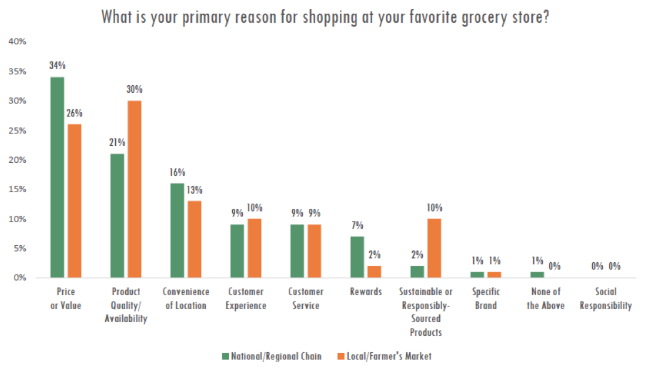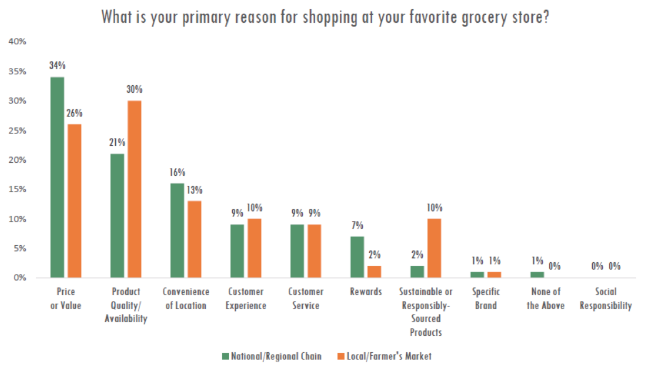Grocery shopping – everyone does it, but no two shoppers are the same. Some shop every day, some once a week. To varying degrees, they prioritize pricing, quality of goods, and customer service. And, increasingly, they’re doing it online.
Here at TrendSource Trusted Insight, we wanted to uncover some of the latest trends and consumer preferences shaping the grocery industry landscape. For our Grocery Insights Study, over a two-week period, we surveyed over 3,000 Field Agents to offer a glimpse into shoppers’ motivations, priorities, and pain points.
The results are in.
Links and Chains: National and Regional Stores Dominate
When it comes to regional/national chains vs. local stores/farmer’s markets, 80% of our respondents indicated they have a favorite grocery store. The staggering majority (90%) of those respondents favored a national/regional chain, while only 10% preferred a local store/farmer’s market.
Digging deeper, study results showed that the motivating factors for selecting a favorite grocery store varied among these two groups. Price and value were most important to those devoted to a chain store, while product quality and availability drove customers to local and farmer’s markets.

The Online Revolution?
While every day consumers are reminded that Amazon is killing the traditional grocery store, the Grocery Consumer Insights Study results say, not so fast! Only 22% of respondents have ever ordered groceries online, and of those people, over 90% reported that online represented less than 25% of their total grocery purchases.
So according to our study, it seems that even those who have already jumped into the online shopping pool have done so with some trepidation, not diving in head first but instead slowly wetting their toes.
Online, Convenience is King
Yet this doesn’t mean grocers should get too comfortable. Those shoppers who had ordered groceries online overwhelmingly cited convenience (66%) as their primary motivator.
Similarly, though only 27% of respondents were familiar with Amazon Dash, over half of those shoppers said it was something they envision themselves using, once again with convenience being the overwhelming motivational factor (69%). The numbers tell us Amazon has some serious room to grow.
And grow it will—64% of respondents with online shopping experience prefer national online vendors to local stores with online ordering options, and over half of those respondents (54%) use Amazon Fresh. Though it may not dominate all grocery, according to our study, Amazon certainly dominates online.
Coupons a Saving Grace
One preference that remained constant across all channels: coupons. A resounding 82% of all respondents indicated they use them, with a roughly equal number of those respondents saying they find them online (45%) and in the newspaper (39%). Another 16% said they find them in the store.
As grocers look to draw value-seeking crowds, coupons still appear to be a primary and effective tool that continues to resonate with customers.
Customer Service, Diet, Budget: What Else the Numbers Tell Us
Beyond these key findings, the study explores an array of other variables shaping customers’ in-store priorities grocery shopping decisions.
For example, how does a consumer’s diet influence their willingness to purchase organic and sustainable foods? It seems eating meat has a lot to do with it. Study results showed that while only 37% of shoppers who identify as carnivores/omnivores said they were at least somewhat willing to pay a premium price for organic and sustainably sourced food, a whopping 67% of vegetarians/pescetarians/vegans were similarly inclined.
How else do dietary preferences influence consumers’ grocery decisions? What services and behaviors do customers expect from employees and, more importantly, what do they want? How many people does the typical consumer shop for and what is their typical monthly budget?
Find the answers to these and other questions by downloading the complete study.


